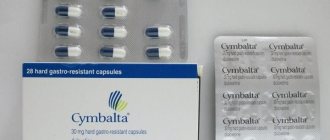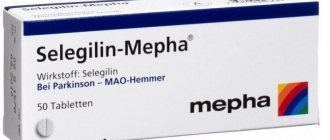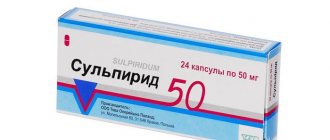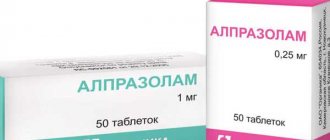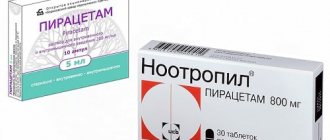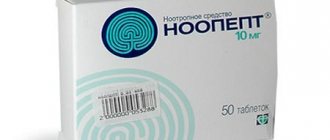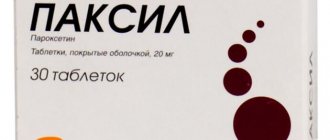The drug "Mezapam", instructions for use, reviews of which will be brought to your attention later in the article, belongs to the category of anxiolytics (tranquilizers), that is, drugs that can combat anxiety, restlessness, irritability and tension that usually accompany depression and other neurotic disorders. This drug is widely used not only in psychiatry, but also in neurology, due to the peculiarities of its effect on the human body.
Pharmacological action of Mezapam
Mezapam is an anxiolytic drug derived from a benzodiazepine. It has muscle relaxant, anxiolytic and antiepileptic effects, and has a not very pronounced thymoleptic effect. Its antiepileptic, hypnotic, central muscle relaxant and sedative effects are less pronounced than those of conventional benzodiazepine tranquilizers, and therefore the drug is classified as a “daytime” tranquilizer.
Mezapam, interacting with the receptors of the limbic system and the activating ascending formation of the brain stem, helps open chloride channels, enhancing the inhibitory effect of GABA in the central nervous system.
The drug Mezapam relieves anxiety, psychoneurotic tension, eliminates feelings of fear, eliminates general motor agitation and excessive fussiness, helps restore emotional behavior and stabilizes the autonomic nervous system. Helps restore a critical assessment of your illness.
Warning to Buyers
In the article, you were offered a description of the drug “Mezapam” (reviews, instructions, price), from which, we hope, you can draw clear conclusions that this drug is effective and relatively inexpensive. At the same time, you should under no circumstances prescribe it to yourself without consulting a specialist.
Incorrect dosage of the drug can lead to tachycardia, catalepsy, a sharp decrease in blood pressure and respiratory depression. This requires urgent medical attention to stabilize the condition and restore basic vital functions.
Remember that these tablets are not a regular sedative. Therefore, by prescribing them yourself, without consulting a doctor, you can cause irreparable harm to your health. Be prudent, don't take risks!
Contraindications
According to the instructions, Mezapam is not used for:
- myasthenia gravis;
- drug and alcohol addiction;
- sleep apnea;
- acute kidney and liver diseases;
- hypersensitivity to medazepam.
The drug is also contraindicated in children under 10 years of age and pregnant women in the first trimester of pregnancy and during breastfeeding.
Mezapam should be used with caution when:
- cerebellar and spinal ataxia;
- organic lesions of the central nervous system;
- intraocular hypertension;
- respiratory failure;
- general serious condition;
- liver or kidney failure;
as well as in old age.
Mezapam: reviews
From the outside I give the impression of a person happy with his life. But inside, under the outer veneer, despair rules... Irvin Yalom, “When Nietzsche Wept” After a while, I remember the events of three years ago as if behind a veil of fog... As if this was not happening to me... I remember like pictures from a banal melodrama... In the spring In 2020, my long-awaited second pregnancy ended. Those who follow my reviews already know that my journey for my son was long. At that moment, I couldn’t believe that this happened to me... Again to me... The same hospital room, the same quiet May night, the same doctor, and the same sentence “frozen pregnancy”... And then everything fell like snow com... Enormous problems at my favorite job, to which I devoted 7 years. Serious problems …
Directions for use and dosage
Mezapam is prescribed to adults 5 mg 2-3 times a day at the beginning of treatment, then the dose is increased to 30 mg per day.
On an outpatient basis, it is recommended to take 5 mg of the drug in the morning and afternoon and 10 mg of the drug in the evening. If necessary, the dose can be increased to 40 mg per day.
For elderly people and adolescents, according to the instructions, Mezapam is prescribed 10-20 mg per day; children over 10 years old – 2 mg/kg/day.
The duration of treatment depends on the disease and the patient's response to taking the drug.
The maximum daily dose of the drug is 40 mg (for outpatient treatment) and 60 mg (in hospital).
Pharmacokinetics
After oral administration, it is quickly absorbed. Absorption is 49-75%. Cmax is reached within 1-2 hours. Protein binding is 99.8%. Metabolized by hydroxylation, N-demethylation, oxidation with the formation of active metabolites: desmethylmedazepam (nordiazepam), diazepam, desmethyldiazepam, oxazepam (7.1% of the dose).
Nordiazepam has a long half-life, accumulates in the body and has a pronounced sedative effect. Metabolites associated with glucuronic acid are excreted by the kidneys (63-85%) and through the intestines (15-37%). T1/2 - 20-176 hours. After completion of administration, significant concentrations of metabolites in plasma are determined for another 3-14 days (they have a long T1/2).
Side effects of Mezapam
According to reviews, Mezapam can cause various side effects.
- Cardiovascular system: decreased blood pressure, tachycardia;
- Central nervous system and peripheral nervous system: drowsiness, mild fatigue, weakness, headache (disappears after reducing doses), stupor, dizziness, anterograde amnesia, accommodation paresis, confusion, depression, dysarthria;
- Respiratory system: depression of the respiratory center, alveolar hypoventilation;
- Endocrine system: menstrual irregularities, decreased potency, decreased libido;
- Digestive system: dyspepsia, dry mouth;
- Others: vocal cord spasm, urinary retention, withdrawal syndrome, chest pain, drug dependence, paradoxical reactions, allergic reactions.
In children and elderly patients, loss of orientation, aggressiveness, lack of inhibition, and increased muscle fatigue are possible.
Indications for use
- Psychopathy, neuroses, neurosis-like and psychopath-like states, accompanied by fear, decreased mood, increased excitability, tension, irritability, anxiety, emotional lability;
- Psychovegetative and psychosomatic disorders, including menopausal syndrome, vegetative-vascular dystonia, migraine (prevention of attacks), sleep disorders, functional disorders of the gastrointestinal tract and cardiovascular system;
- School neuroses, excessive excitability and mental lability in children;
- Alcohol withdrawal syndrome (uncomplicated), delayed neurotic disorders developing in the structure of remission of drug addiction and alcoholism (as part of complex therapy).
Interaction with other drugs
When Mezapam is used simultaneously with centrally acting antihypertensives, anticoagulants, beta-blockers, the results of the interaction may be unpredictable.
When used together with anesthesia, opioid analgesics, ethanol, and muscle relaxants, the inhibitory effect on the central nervous system may be enhanced.
When using Mezapam with cimetidine, the intensity and duration of action of the former may increase.
Phenytoin and barbiturates can reduce the effectiveness of Mezapam.
Oral contraceptives inhibit the metabolism of medazepam, leading to an increase in the duration and intensity of its action.
Mezapam enhances the effect of phenytoin and reduces the effectiveness of levodopa.
INSTRUCTIONS for the use of the drug for medical use Mezapam
Trade name: Mezapam International nonproprietary name: Medazepam Chemical name: 7-Chloro-2,3-dihydro-1-methyl-5-phenyl-1H-1,4-benzodiazepine Dosage form: tablets. 1 tablet of the drug contains the active substance mezapam - 10 mg, excipients: lactose monohydrate (milk sugar) - 69 mg, potato starch - 20 mg, calcium stearate (calcium stearate) - 1 mg. Description: Light yellow, flat-cylindrical tablets. Pharmacotherapeutic group: Anxiolytic agent (tranquilizer). List III of the list of narcotic drugs, psychotropic substances and their precursors subject to control in the Russian Federation. ATX code: [X05BA03]
Pharmacological properties
Pharmacodynamics Mezapam is a “daytime” anxiolytic drug (tranquilizer) from the group of benzodiazepines, has anxiolytic, muscle relaxant and antiepileptic effects, and has a slightly pronounced thymoleptic effect. Interacts with benzodiazepine receptors of the limbic system and the ascending activating formation of the brain stem, promotes the opening of Cl - channels, which leads to increased inhibitory effects of GABA in the central nervous system. Eliminates anxiety, fear, psychoneurotic tension, general motor agitation, excessive fussiness, restores emotional behavior and has a stabilizing effect on the autonomic nervous system. Restores a critical assessment of one’s own illness. Antiepileptic, central muscle relaxant, sedative and hypnotic effects are less pronounced than those of typical benzodiazepine anxiolytic drugs (tranquilizers).
Pharmacokinetics: After oral administration, it is rapidly absorbed. Absorption - 49-75%. The time required to achieve maximum concentration is 1-2 hours. Communication with plasma proteins is 99.8%. Metabolized by hydroxylation, N-demethylation, oxidation with the formation of active metabolites: desmethylmedazepam (nordiazepam), diazepam, dimethyldiazepam, oxazepam (7.1% of the dose). Nordiazepam has a long half-life (T1/2), accumulates in the body and has a pronounced sedative effect. Excretion of metabolites associated with glucuronic acid by the kidneys (63-85%) and through the intestines (15-37%). T1/2 - 20-176 hours. After completion of administration, significant concentrations of metabolites in plasma are determined for another 3-14 days (they have a long T1/2).
Indications for use:
Neurotic and neurosis-like disorders; psychosomatic and autonomic disorders, alcohol withdrawal syndrome (in complex therapy). In children - mental lability, excessive excitability.
Contraindications for use:
Hypersensitivity, myasthenia gravis, acute liver and kidney diseases, sleep apnea, alcohol and drug addiction, children (up to 10 years), lactase deficiency, lactose intolerance, glucose-galactose malabsorption.
Carefully:
Hepatic and/or renal failure, pregnancy, spinal and cerebellar ataxia, intraocular hypertension, organic lesions of the central nervous system, respiratory failure, old age, general severity of the condition.
Dosage regimen, method of administration, duration of treatment:
Orally, before meals, doses are selected individually, for neurotic and neurosis-like disorders 2-3 times a day, initial single dose 10 mg, initial daily dose - 20 mg, gradually increasing the dose to 30 mg / day (if necessary - up to 40 mg /day); for psychosomatic and autonomic disorders from 20 to 40 mg per day (on average 30 mg: 1 tablet 3 times a day). When treating alcohol withdrawal syndrome, 30 mg/day is prescribed for 1-2 weeks. For adults, the average single dose is 10-20 mg. The average daily dose is 30-40 mg. The maximum daily dose for adults is 40 mg (in outpatient settings) and 60-70 mg (in hospital settings). The duration of the course of treatment is determined individually, on average no more than 2 months, a repeat course - after a break (at least 3 weeks). Elderly people and adolescents are prescribed 10-20 mg/day.
Precautions for use:
Use strictly as prescribed by your doctor to avoid complications. During the treatment period, it may cause difficulty in remembering and learning; you should refrain from drinking ethanol. When treating and preventing the development of withdrawal syndrome, withdrawal is carried out gradually. Prescribed for a short time, with long-term use the formation of drug dependence is possible (with an excessive increase in dose - the development of tolerance and mental dependence).
Symptoms of overdose, measures to help in case of overdose:
Symptoms: feeling of fatigue, catalepsy, ataxia, tachycardia, decreased blood pressure, muscle hypotension; in severe cases - coma, convulsions, respiratory depression. Treatment: gastric lavage, activated charcoal and laxatives, intravenous fluids, monitoring respiratory rate, heart rate, blood pressure and body temperature, general measures aimed at maintaining the basic vital functions of the body, and preparing all the conditions necessary for emergency care help with the possible development of airway obstruction. Forced diuresis and hemodialysis are ineffective.
Possible side effects when using the drug:
Mezapam is usually well tolerated. From the nervous system: drowsiness, headache (the first reaction to administration, disappearing after reducing the dose), weakness, dizziness, stunnedness, anterograde amnesia, depression, confusion, dysarthria, ataxia (in elderly patients and patients with mental retardation), paresis accommodation; in elderly patients and children - loss of orientation in space, disinhibition, aggressiveness. From the cardiovascular system: tachycardia, decreased blood pressure. From the digestive system: dry mouth, dyspepsia, increased activity of “liver” transaminases. From the respiratory system: depression of the respiratory center (with airway obstruction or brain damage), alveolar hypoventilation (in patients with chronic obstructive pulmonary disease when taken in high doses). Other: decreased potency and/or libido, dysmenorrhea, urinary retention, spasm of the vocal cords (with temporary cessation of breathing), chest pain, withdrawal syndrome, paradoxical reactions, drug dependence (especially with long-term use), allergic reactions.
Interaction with other drugs:
With simultaneous use, there is a mutual enhancement of the effects of ethanol, narcotic analgesics, drugs for general anesthesia, centrally acting muscle relaxants, barbiturates, hypnotics, and antidepressants. When taking centrally acting antihypertensive drugs and beta-blockers simultaneously, the sedative and hypotensive effects may be excessively enhanced. When used together with anticoagulants, the activity of indirect anticoagulants decreases. Inhibitors of microsomal liver enzymes (cimetidine) enhance and prolong the effect, inducers (barbiturates and phenytoin) weaken. Oral contraceptives may delay the metabolism of mezapam, resulting in an increase in the intensity and duration of its action. Reduces the effect of levodopa, enhances the effect of phenytoin (inhibition of the latter).
Possibility and features of medical use of the drug by pregnant women and women during breastfeeding:
The use of Mezapam during pregnancy (first trimester) and lactation is contraindicated. If use is necessary during breastfeeding, breastfeeding should be discontinued.
Information about the possible effect on the ability to drive vehicles and machinery:
During the treatment period, care must be taken when driving vehicles and engaging in other potentially hazardous activities that require increased concentration and speed of psychomotor reactions.
Shelf life: 5 years. Do not use after the expiration date stated on the packaging. Release form: Tablets 10 mg. 5 contour blister packs of 10 tablets or 50 tablets in a light-protective glass jar or polymer jar along with instructions for use in a cardboard box. Storage conditions: List III of the list of narcotic drugs, psychotropic substances and their precursors subject to control in the Russian Federation. Store in a place protected from light at a temperature not exceeding 30 °C. Keep out of the reach of children. Name, address of the manufacturer of the medicinal product and address of production of the medicinal product: OJSC Organika, Russia, 654034, Kemerovo region, Novokuznetsk, Kuznetskoe highway, 3, tel., fax: 37-24-96
special instructions
According to reviews, it is better to take Mezapam for a short period, since long-term use, especially in large doses, leads to drug dependence. In rare cases, physical dependence on the drug occurs, but if the dose is greatly exceeded, tolerance and mental dependence develop. To prevent the onset of withdrawal symptoms, the drug should be discontinued gradually.
During treatment with Mezapam, alcohol consumption is not allowed.
Reviews of Mezapam indicate that the drug inhibits the processes of memory and learning ability.
While taking Mezapam, it is not recommended to engage in activities that require rapid psychomotor reactions.
Composition and cost
Composition of Mezapam:
- active ingredient – medazepam (7-Chloro-2, 3-dihydro-1 methyl-5-phenyl-1H -1, 4-benzodiazepine);
- lactose monohydrate;
- potato starch;
- calcium stearate.
The price of Mezapam ranges from 175 to 220 rubles, depending on the pharmacy and manufacturer.
Pharmacokinetics
After oral administration, it is absorbed quickly, maximum plasma concentrations are recorded two hours after administration. Maximum absorption – 75%.
During metabolism, it is hydroxylated and demethylated, resulting in the formation of active metabolites: diazepam, desmethyldiazepam, oxazepam.
It has the ability to accumulate, metabolites are excreted by the kidneys up to 85%, and to a lesser extent by the intestines. Metabolites have a long half-life - up to 176 hours. At the end of taking Mezapam, the concentrations of metabolites are detected in the blood plasma for another two weeks.
Release form and admission rules
The dosage form of Mezapam is tablets, 50 pieces in a dark glass bottle. The concentration of the active substance is 10 mg per tablet. Therapy begins with small doses of the drug, gradually increasing the daily dose. Adjustments to the dosage regimen are made only by the attending physician.
Mezapam can also be produced in the form of powder and granules for the preparation of oral suspensions - this form of the drug is preferred when prescribing the drug to children.
In outpatient treatment, minimal doses of the drug are used. For children over ten years of age, the dosage is calculated based on body weight. Take three times a day. In a hospital setting, average concentrations may be exceeded if the patient’s individual response to treatment is normal and no significant side effects are observed. The duration of the course is determined by the attending physician and depends on the medical history of the disease.
Adverse reactions
Mezapam exhibits a number of adverse reactions, which may be an indication for discontinuation of the drug, according to the decision of the attending physician.
Reactions from the central nervous system
The central and peripheral nervous systems may react with a feeling of lethargy, drowsiness, headache, weakness, confusion, paresis, and dizziness. In the first days of taking the drug, headache is observed in many patients and is eliminated by reducing the dose of the drug.
During therapy with Mezapam, children and the elderly may experience aggressiveness, decreased ability to navigate, and muscle weakness. When treating patients with mental retardation, ataxia may occur.
Endocrine system
While taking Mezapam, the endocrine system may respond with fluctuations in the menstrual cycle, decreased libido and potency.
The cardiovascular system
The heart may respond with low blood pressure and tachycardia.
Respiratory system
With obstructive diseases or brain injuries, the respiratory center is depressed. In patients with chronic obstructive diseases, alveolar hypoventilation may develop when treated with Mezapam in high doses.
Other reactions
From the gastrointestinal tract, functional digestive disorders and a feeling of dry mouth are observed. Other reactions include pain in the chest area, voice changes, withdrawal symptoms, possible dependence during long-term treatment with Mezapam, and allergic reactions on the skin.
Contraindications
Mezapam is contraindicated for kidney and liver diseases in the acute phase, myasthenia gravis, and individual hypersensitivity to medazepam. It is not prescribed to patients with sleep apnea, dependence on alcohol and drugs, while pregnant and breastfeeding. Children under ten years of age should not take Mezapam.
Analogues of Mezapam in terms of the active substance are the drugs Medazepam, Nobrium, Nobritem, Rudotel. Analogs for therapeutic effect are Adaptol, Gidazepam, Afobazol, Phenazepam, Oxilidin, Seduxen, Temazepam.
Overdose
Symptoms of drug overdose: arrhythmia, confusion, drowsiness, inhibition of reactions, fatigue, ataxia, low muscle tone. In case of severe overdose - muscle cramps, coma, depression of the respiratory centers, even death.
To relieve these conditions, the patient is given activated charcoal and laxatives; in a hospital setting, breathing, blood pressure, heart rate and temperature are monitored and adjusted. In severe cases, a specific antagonist of benzodiazepine derivatives, flumazenil, is used.
Drug interactions
Mezapam's ability to enhance the effect of drugs that exhibit a similar effect by depressing the central nervous system has been observed. This interaction is observed when used simultaneously with hypnotics, neuroleptics, narcotic analgesics, anesthetics, and antihistamines containing sedative components.
Mezapam and alcohol can give a paradoxical reaction - this means that when taken simultaneously, instead of the expected effect, excitability, aggressiveness, anxiety, irritability, and nervous tension will appear. A similar effect can be observed when taken simultaneously with ethanol-containing drugs. For patients undergoing treatment for alcohol dependence, the dosage is increased gradually, and also gradually reduced until complete cessation of use in order to prevent withdrawal syndrome.
Oral contraceptives containing estrogen enhance the effect of the drug and slow down its elimination from the body. Nicotine, on the contrary, shortens the half-life.
Available in tablets.
Medicinal properties
Price 835-900 rubles.
The medication is classified as a benzodiazepine tranquilizer. It has a pronounced calming effect, the product helps relieve emotional stress, reduce the manifestations of fear and anxiety. It also has vegetative stabilizing activity. Compared to other drugs of similar action, it has a lesser hypnosedative effect, and therefore belongs to the category of “daytime” tranquilizers.
Absorption occurs very quickly, the maximum concentration of the active substance is already observed 1-2 hours after administration. It is excreted mainly through the urinary system and intestines.

